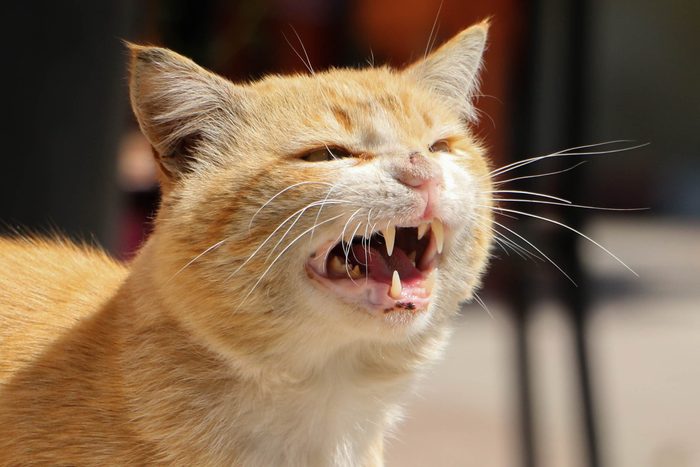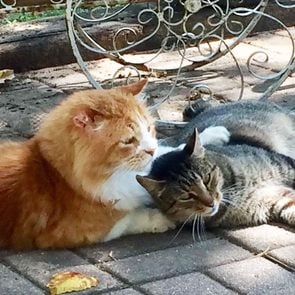Why Do Cats Hiss?
Updated: Dec. 19, 2023

Your cat meows, chirps, and growls, but have you ever wondered why cats hiss?
Hissing is a commonly misinterpreted cat behavior. Cat vocalizations, such as purring, chirping, meowing, growling, yowling, chattering, and, yes, hissing are all tools used for communication. If you’ve wondered why do cats hiss and how to calm a hissing cat, you’ve come to the right place. Also, find out if cats get jealous and why scruffing a cat is a big no-no!
Why do cats hiss?
When you witness a cat hissing, with its teeth exposed, it looks like an act of aggression. Cats typically hiss when they are faced with a threat—be it an animal or human they consider to be invading their personal space. “Hissing is more defensive than offensive,” Stephanie Sheen, DVM at Fuzzy Pet Health. “They’re letting the target of their hiss know what weapons they’re working with.” To that end, hissing is often accompanied by showing their sharp and pointy teeth. If the cat is pushed further, they might resort to more physical behavior such as biting or swatting.
Hissing may also occur when the cat feels unsure, annoyed, or in pain. If your cat hisses when certain areas of the body are touched, it could be a sign of discomfort. Older cats may hiss to express discomfort from arthritis. If your cat’s hissing is a new behavior, Dr. Sheen says a visit to the veterinarian is in order. “Medical evaluation should be sought out immediately if hissing is accompanied by other behavioral changes, such as low energy, hiding, or decreased appetite, which can indicate a more serious illness.”
Kittens practice hissing as early as two weeks old, around the time they begin to open their eyes and ears. They often “play hiss” to let their siblings know when things are getting too aggressive, explains Dr. Sheen. Mother cats hiss to set boundaries around acceptable behavior and to express annoyance. “They may also hiss during the weaning process to let the kittens know they are no longer a source of food,” she adds.
How do cats hiss?
When a cat hisses, according to Dr. Sheen, it is quickly exhaling a burst of air through its mouth. This creates a sound similar to a snake’s hiss. Needless to say, the sound of a snake hissing is enough to scare most of us. “There is some thought that this is an imitation behavior adopted by cats, which is common in the animal world,” shares Dr. Sheen.
Hissing is sometimes associated with a cat’s body language, such as pinned back ears, dilated pupils, a flicking tail, and hair standing up. Dr. Sheen explains that these “are all physical responses to the feeling of being unsafe—the fight-or-flight response.”
How do you calm a hissing cat?
Hissing is usually the last-ditch effort a cat makes before getting physical. Even cats with loving parents tend to hiss from time to time, especially when they no longer want to be pet. For example, just because the cat is showing her belly, doesn’t mean it’s an invitation to pet. (That’s actually one of the things pet parents do that cats secretly hate.) “This does not mean they have negative feelings toward their pet parents, but is rather a situational expression of unease,” suggests Dr. Sheen.
Because hissing is rooted in fear, it’s important not to punish the cat verbally or physically. Dr. Sheen advises acting with empathy and understanding the animal’s underlying need to feel safe and respected. That means, most importantly, giving the cat time and space. “Don’t push further physical contact, such as petting, touching, or picking up the cat. It is helpful to also avoid eye contact and allow the cat to retreat to a safe space to calm down,” says Dr. Sheen. Wait for the cat to come to you when she’s ready.
In a situation where the cat is hissing at a stranger or an object, using desensitization and counterconditioning techniques can help the feline. Dr. Sheen recommends giving treats from afar, or putting down tasty canned food nearby, to help associate positivity with the fearful triggers, so the cat can become less afraid over time. “Never force a cat to interact with something they are afraid of.”
How to address cats hissing at each other
If hissing is occurring between cats, separate them immediately, if you are able to do so safely, to avoid injury to the animals in the event of a physical fight. In the case of inter-cat aggression, Dr. Sheen says, “the cat who is doing most of the hissing is likely to be the victim rather than the aggressor. The aggressor cat often shows threatening behaviors like staring or stalking toward the other cat.” A veterinary behaviorist can help manage inter-cat issues with environmental and behavioral medications. If you need a quicker, at-home fix, here’s how to stop a cat from bullying another cat.
How to address a cat hissing at a dog
Cats often react to dogs and puppies by hissing when they feel trapped or unable to escape. According to Dr. Sheen, if your household also has canines, it’s key to discourage the dog’s chasing behavior through training and also provide multiple vertical spaces, such as perches or cat trees, for the cat to escape when the need arises. “This will create safe spaces that can prevent an aggressive escalation between the two.”
Sources:
- Stephanie Sheen, DVM at Fuzzy Pet Health





















